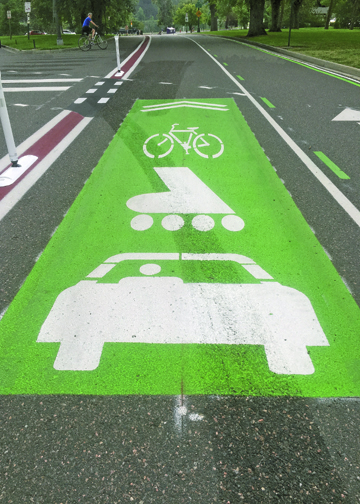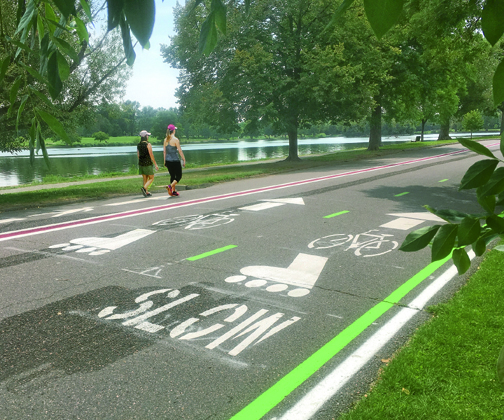Some Residents, Users Say The Revamped Loop Road Completed This Summer Is A Travesty
by Glen Richardson

 Denver’s Washington Park was acquired in increments between 1899 and 1904 and designed in stages by Reinhard Schuetz as a green space of lakes, gardens, trees, open area and vistas to be peacefully and quietly enjoyed by the public. “Denver’s Parks & Recreation has un-greened the park by painting red, green and white lines on pavement everywhere and installing controlling signs and stanchions to herd pedestrians, facilitate autos and especially bicycle passage,” declares resident Frank Hegner.
Denver’s Washington Park was acquired in increments between 1899 and 1904 and designed in stages by Reinhard Schuetz as a green space of lakes, gardens, trees, open area and vistas to be peacefully and quietly enjoyed by the public. “Denver’s Parks & Recreation has un-greened the park by painting red, green and white lines on pavement everywhere and installing controlling signs and stanchions to herd pedestrians, facilitate autos and especially bicycle passage,” declares resident Frank Hegner.
Hegner is talking about the 2.2-mile stretch of pavement known as the Loop Road that encircles the park. Changes and a new addition to the route completed this summer threw him and hundreds of other park users for a loop. He tells the Chronicle, “It is only a matter of time before someone is seriously hurt in these merging, confusing lanes of unsightly, costly insanity.”
It is the addition of a third lane not familiar to pedestrians and bicyclists that upset users the most. It’s a “bicycle alley” created by the city as a new fast lane designed especially for them, many tell the Chronicle. “You’d think there was a race track out there,” says David Matthews. He should know, he’s been walking and pedaling the route for 45 years and is a board member of the West Wash Park Neighborhood Assn. In addition to the fast lane the city has painted 150 new stencils on the asphalt path, installed 100 vertical signs explaining the new layout and erected a series of barriers to block cars from turning onto the loop. All at a cost of nearly a quarter of a million dollars.
Political Process
Denver Parks & Recreation’s response is that the changes were made based on comments from residents. “It’s not something we invented,” retorts project supervisor Jason Himick. It is true the parks department listened to residents at three public meetings plus published a 100-page report outlining the plans. In rejoinder, many users tell the Chronicle, “It’s part of the political process whether for a proposed urban development or planned park changes, but the City’s strategy policy always remains unchanged.”
One unidentified speaker at the public meetings even appeared to warn attendees that Parks & Recreation were only practicing a political process: “I’ve had enough experience in the world and as an attorney to know that once consultants are hired, somebody has made up their mind to do something. I would urge that as little as possible be done.” Belinda Bagley who lives on South Franklin says the most accurate statement made by department consultants during those meetings was that the majority of people who use the Park were satisfied with it and did not wish to see it changed. At those meetings she pointed out, “Most of the time the park is not crowded. There are a few peak times when congestion might cause various difficulties, but that is the exception rather than the rule.”
There are, of course, those that are happy with the changes including Tim McHugh, President of FANs (Friends & Neighbors of Wash Park). He says the process included, “a wide variety of park users who consider th e best interests of all who use the Loop Road.” Frank Miltenberger — another park stakeholder — believes the process was fair, though not everyone got everything they wanted.
e best interests of all who use the Loop Road.” Frank Miltenberger — another park stakeholder — believes the process was fair, though not everyone got everything they wanted.
Safety Concerns Overlooked
The single thing residents and users at the public meetings seemed to agree on was that speed is a worry. “Slow is safe,” many suggested. Furthermore, a number of people spoke about concerns, even fear, of bicycles moving at fast speeds. “Anyone moving at speeds that do not allow for quick stops or turns is a concern. The slower the safer,” warned Glen Legowik.
Matthews — the FANs board member who objects to the changes because of bike speed — personally witnessed a serious accident when a bicyclist entering the park from Marion Parkway hit a car coming out. He’s seen less serious altercations among bicyclists and pedestrians when one strays into the other’s lane. “There just need to be a few things that say, ‘slow down, it’s not a race track.’ I’m not at all against people riding their bikes here, but we’ve got to have some way to do it safely.”
As for the signage, Humboldt Street’s Jenna Moore admits the former one-way arrows confused people. But she says all that was needed was to paint an additional arrow pointing the opposite direction where the original pedestrian arrows were painted. Similarly, signage that informed cyclists that they need to stay in their lane would have helped.
Baffling Symbols
For Washington Park Loop Road bikers, walkers, runners, rollerbl ading, and dogs this is what the lanes ahead now look like: The two outer lanes are for one-way wheeled traffic only, each marked by a bicycle and a rollerblade stencil. Unfortunately, however, many are confusing the rollerblade symbol as a footprint-marker indicating use for pedestrian traffic.
ading, and dogs this is what the lanes ahead now look like: The two outer lanes are for one-way wheeled traffic only, each marked by a bicycle and a rollerblade stencil. Unfortunately, however, many are confusing the rollerblade symbol as a footprint-marker indicating use for pedestrian traffic.
The outermost lane is slower; the middle lane is for passing. In at least one stretch the middle lanes open up to car traffic, too. The pedestrian lane, closest to the park interior, has a pedestrian symbol and is reserved for foot traffic and leashed dogs walking in both directions.
Critic Matthews suggests that adding the new lane has squeezed pedestrians to one side. Furthermore, he notes the entire metro area has 10-foot bike paths for two-way traffic but all of a sudden 18-feet is required in Wash Park.
Flawed Process
Ultimately many Washington Park residents feel they were in some sense conned once again by the Hancock Administration generally and the Parks & Recreation Department specifically. Many believe that the administration is attempting to control traffic by making owning an automobile a difficult and expensive proposition.
The transportation alternative preferred by the administration for most people is either bicycles or public transportation. Thus when the Wash Park Loop was being conceptualized the city’s preference for bicycles overrode any input from local residents at the meetings concerning pedestrian travel.
What were all those meetings about?” demanded Matthews of the Deputy Manager of Parks & Recreation Scott Gilmore, who off
ered to “remove some curb” at the narrowest points in the pedestrian lane. (Parks & Recreation later did this.)
But Matthews was angry. “Sc
ott, you took the side of the bikes. They have 18 feet! What about the people?”
Gilmore finally retorted that there were many other paths for people to walk on in Washington Park.
“What I’ve found in this job,” Gilmore said wearily, “is that you can never please everyone. Never. They wanted a safer road. It is so much safer.”
Gilmore did acknowledge he could have “communicated more fully” at various points. “But nobody likes change.”
Back in 2014, the stakeholders asked that the Loop Road’s essential nature not be changed — and that everyone who wanted to use it be accommodated.
It appears Parks & Recreation saw both things weren’t exactly possible. Residents argue that with more honest communication, stakeholders could have been true partners in envisioning the outcome — instead of, as Matthews feared, “being just used to show there was public input.”
